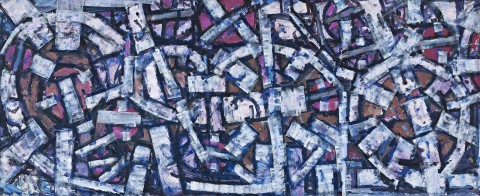SEQUENCE EIGHTEEN 1968 – 75
ROGER KEMP
synthetic polymer paint on paper on canvas
151.0 x 367.5 cm
Estate of the artist, Melbourne
Eastgate & Holst Fine Art, Melbourne
Private collection, Melbourne,
acquired from the above in June 2006
Roger Kemp: Cycles and Directions 1935-1975 – Sequences 1968 – 1975, National Gallery of Victoria, Melbourne, 5 – 30 September 1978
Roger Kemp, Eastgate & Holst Fine Art, Melbourne, 18 March – 22 April 2006, cat. 26
Roger Kemp: Cycles and Directions 1935-1975, Monash University, Melbourne, 1978, cat. 90 (illus., unpaginated)
Heathcote, C., A Quest for Enlightenment: The Art of Roger Kemp, Macmillan, Melbourne, 2007, pp. 230 – 231 (illus.)
Sequence Eighteen, 1973 – 75 shows Roger Kemp painting at full concentration. It is the result of an innovative method of contemporary abstraction he developed after two intense years spent overseas. Besides mixing with cultural identities and soaking up art in museums, Kemp was invited by the major British painter Bridget Riley to use a vacant section of her large studio-warehouse. This had enabled Kemp to attempt work on the grand scale of American and European abstractionists. So, upon returning to Melbourne, he rented a similar warehouse off Flinders Street, where he had the space, solitude and vision to paint in an international vein.
Sequence Eighteen is a bold, gutsy composition produced in that studio. Roger Kemp unfurled and fixed a wide roll of French art paper along his studio wall, then painted upon it a compositional structure of circles and bars using thinned acrylic. There was a serious point to his abstract geometry. The artist wished to suggest the perceptions of physicists and scientists who talk of implicit rational systems behind the seemingly haphazard world. Indeed, Kemp’s big theme in Sequence Eighteen is the grand pattern evident behind the restless turmoil of an ever-changing universe.
Mind you, Sequence Eighteen is a long way from a physics diagram. The artist has not plotted out scientific ideas with compasses, rulers or numbered ratios. Instead, cosmic order is implied in a semi-visionary composition that owes much to that tradition followed by European masters like Wassily Kandinsky and František Kupka, as well as Kemp’s New York contemporaries, the celebrated Abstract Expressionists.
Having defined his design basis the artist then set to work on Sequence Eighteen with full bodied American acrylics, sometimes interchanging broad brushes with imported paint rollers. Kemp used these sponge rollers – which were unknown in Australia – as a way to avoid resorting to ‘fill’. They allowed him to apply acrylic as an irreducible rectangle. Forms were not coloured in, he would say, they denoted elementary units as in physics.
We can see Sequence Eighteen also involved a creative process of distribution and then layering. In early stages of the painting, Kemp distributed small coloured blocks and devices, balancing them across the overall composition. They were intended to sit beneath a final surface configuration. This is why, behind those strong white bands and arcs, we can make out a subtle secondary order of shapes in tan, reds, blues and purple structured in a different alignment. When explaining what was intended by doing this, Kemp would switch from scientific talk and refer to how in symphonic music strings or woodwind have assigned passages, their own melodic units, but these all ultimately merge in a dominant musical structure. And, much as a composer must weave the separate parts played by different instruments into a cohesive symphony, so too was Kemp striving to orchestrate subsidiary forms into a grand unity. Sequence Eighteen is a mighty work of art. Exhibited at the National Gallery of Victoria soon after completion, it signals this pioneering creator moving to the forefront of modern Australian painting.
DR CHRISTOPHER HEATHCOTE
